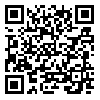Volume 15, Issue 1 (Vol.15, No.1 2019)
irje 2019, 15(1): 95-104 |
Back to browse issues page
Download citation:
BibTeX | RIS | EndNote | Medlars | ProCite | Reference Manager | RefWorks
Send citation to:



BibTeX | RIS | EndNote | Medlars | ProCite | Reference Manager | RefWorks
Send citation to:
Moradi G, Veysi A, Rahmani K, Erfani H, Doosti Irani A, Shirzadi M, et al . Leishmaniasis Surveillance System in the Islamic Republic of Iran: History, Structures and Processes. irje 2019; 15 (1) :95-104
URL: http://irje.tums.ac.ir/article-1-6286-en.html
URL: http://irje.tums.ac.ir/article-1-6286-en.html
Leishmaniasis Surveillance System in the Islamic Republic of Iran: History, Structures and Processes
G Moradi1 
 , A Veysi2
, A Veysi2 
 , K Rahmani3
, K Rahmani3 
 , H Erfani4
, H Erfani4 
 , A Doosti Irani5
, A Doosti Irani5 
 , MR Shirzadi6
, MR Shirzadi6 
 , F Gharachorloo7
, F Gharachorloo7 
 , M Nabav6
, M Nabav6 
 , MM Gouya *
, MM Gouya * 
 8
8

 , A Veysi2
, A Veysi2 
 , K Rahmani3
, K Rahmani3 
 , H Erfani4
, H Erfani4 
 , A Doosti Irani5
, A Doosti Irani5 
 , MR Shirzadi6
, MR Shirzadi6 
 , F Gharachorloo7
, F Gharachorloo7 
 , M Nabav6
, M Nabav6 
 , MM Gouya *
, MM Gouya * 
 8
8
1- Associate Professor of Epidemiology, Social Determinants of Health Research Center, Research Institute for Health Development, Kurdistan University of Medical Sciences, Sanandaj, Iran
2- Assistant Professor of Medical Entomology, Research Institute for Health Development, Zoonoses Research Center, Kurdistan University of Medical Sciences, Sanandaj, Iran
3- Assistant Professor of Epidemiology, Liver and Digestive Research Center, , Research Institute for Health Development, Kurdistan University of Medical Sciences, Sanandaj, Iran
4- MD, Head of Surveillance Office, Centre for Communicable Diseases Control, Ministry of Health and Medical Education, Tehran, Iran
5- Assistant Professor of Epidemiology, Social Determinants of Health Research Center, Hamadan University of Medical Sciences, Hamadan, Iran
6- Assistant Professor of Infectious Diseases, Centre for Communicable Diseases Control, Ministry of Health and Medical Education, Tehran, Iran
7- BS in Public Health, Centre for Communicable Diseases Control, Ministry of Health and Medical Education, Tehran, Iran
8- Associate Professor of Infectious Diseases, Center for Communicable Diseases Control, Ministry of Health & Medical Education, Tehran, Iran ,mgouya57@gmail.com
2- Assistant Professor of Medical Entomology, Research Institute for Health Development, Zoonoses Research Center, Kurdistan University of Medical Sciences, Sanandaj, Iran
3- Assistant Professor of Epidemiology, Liver and Digestive Research Center, , Research Institute for Health Development, Kurdistan University of Medical Sciences, Sanandaj, Iran
4- MD, Head of Surveillance Office, Centre for Communicable Diseases Control, Ministry of Health and Medical Education, Tehran, Iran
5- Assistant Professor of Epidemiology, Social Determinants of Health Research Center, Hamadan University of Medical Sciences, Hamadan, Iran
6- Assistant Professor of Infectious Diseases, Centre for Communicable Diseases Control, Ministry of Health and Medical Education, Tehran, Iran
7- BS in Public Health, Centre for Communicable Diseases Control, Ministry of Health and Medical Education, Tehran, Iran
8- Associate Professor of Infectious Diseases, Center for Communicable Diseases Control, Ministry of Health & Medical Education, Tehran, Iran ,
Abstract: (3712 Views)
Background and Objectives: Leishmaniasis control in each country, especially in countries where the disease is endemic, requires designing and implementing an organized national surveillance system. Iran has long been considered as an endemic country for leishmaniasis. The purpose of this study was to review the leishmaniasis surveillance system in Iran.
Methods: In this review study, the data were obtained from the surveillance system, reports and documents, published guidelines, reviews of the existing structures, and the views of the managers and experts of the Center for Communicable Diseases control in Iran in 2018.
Results: The surveillance system for two types of leishmaniasis, cutaneous leishmaniasis and visceral leishmaniasis (Kala-azar), is currently operational in the country, and new cases are reported monthly. For each identified case, in addition to the epidemiologic attributes, treatment and follow-up as well as follow-up of possible contacts are done as per to the guidelines for each of these diseases.
Conclusion: The current surveillance system for leishmaniasis has improved the process of reporting cases in recent years. However, the low rate of reporting of cases, especially for cutaneous leishmaniasis, and epidemiological complexities in the transmission of the infection indicate the need for reviewing and improving the current surveillance system. Data from the surveillance system and the increasing number of leishmaniasis cases in Iran reveal the need for innovations to strengthen the control measures for this disease.
Methods: In this review study, the data were obtained from the surveillance system, reports and documents, published guidelines, reviews of the existing structures, and the views of the managers and experts of the Center for Communicable Diseases control in Iran in 2018.
Results: The surveillance system for two types of leishmaniasis, cutaneous leishmaniasis and visceral leishmaniasis (Kala-azar), is currently operational in the country, and new cases are reported monthly. For each identified case, in addition to the epidemiologic attributes, treatment and follow-up as well as follow-up of possible contacts are done as per to the guidelines for each of these diseases.
Conclusion: The current surveillance system for leishmaniasis has improved the process of reporting cases in recent years. However, the low rate of reporting of cases, especially for cutaneous leishmaniasis, and epidemiological complexities in the transmission of the infection indicate the need for reviewing and improving the current surveillance system. Data from the surveillance system and the increasing number of leishmaniasis cases in Iran reveal the need for innovations to strengthen the control measures for this disease.
Type of Study: Research |
Subject:
Epidemiology
Received: 2019/08/5 | Accepted: 2019/08/5 | Published: 2019/08/5
Received: 2019/08/5 | Accepted: 2019/08/5 | Published: 2019/08/5
Send email to the article author
| Rights and permissions | |
 |
This work is licensed under a Creative Commons Attribution-NonCommercial 4.0 International License. |



